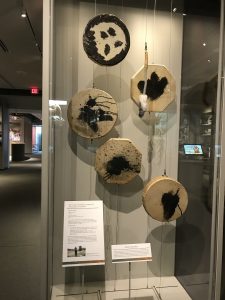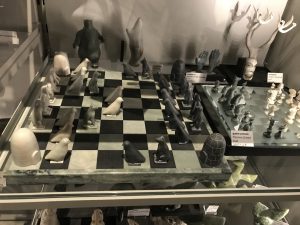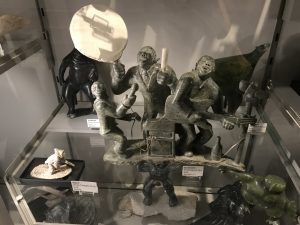Surrounded by ceremonial masks and clothing, relics of time long ago, and entire collections from certain Indigenous groups, Her First Day of School and His First Day of School by Dionne Paul (2013) are a shocking reminder of a dark part of Canada’s history. Two large prints of photographs hang there, one of a girl and one of a boy, both age four and Indigenous, supposedly on their first day of school. They are mostly in colour, except for a square of black and white photo depicting a residential school uniform, clearly from an older photograph, each photoshopped over the torso of the children. The artist’s statement educates the viewer on the subject in case they are ignorant to it, and clearly states its purpose as a reminder of what the first day of school used to mean to Indigenous schoolchildren: being separated from their families, and being punished for practicing their culture.
After growing up in the 2000’s and being taught about the travesty of the residential schools in Canada, I understood the pieces without reading the artist’s statement, and it chilled me to the bone. It took me longer, however, to decide why the curation staff had placed this piece among the traditional dress and historical objects of various Indigenous groups. I believe it was placed among history and culture because it is a representation of this dark place in Indigenous history. The trauma of the residential schools has permanently affected Indigenous culture in Canada, because it devastated almost every Indigenous family in the country and destroyed cultures. It hangs among other historical artifacts in the museum, because in a way, it is also a representation of Indigenous history.
This piece of art hangs to the left of an artwork entitled To Wash Away the Tears, a canoe filled with memorabilia of family members passed. Over 3,000 families are connected by the items in the canoe, which include books, photographs, and figurines owned by the family member honoured. The other objects in the room are historical and culturally significant, including masks and traditional dress. Though Her/His First Day of School and To Wash Away the Tears are both more modern and contemporary works of art, they both represent history and culture the way that the artifacts do. The two works of art, especially His/Her First Day of School, demonstrate the theory of figurative repatriation because though different in execution than the other artifacts displayed, they all capture Indigenous culture in art.


